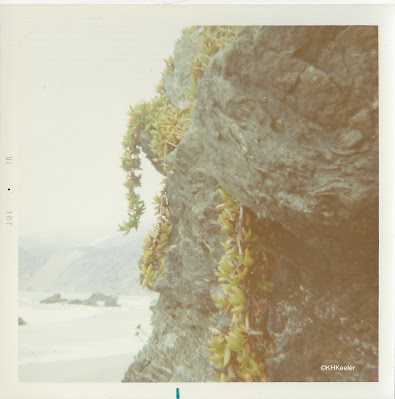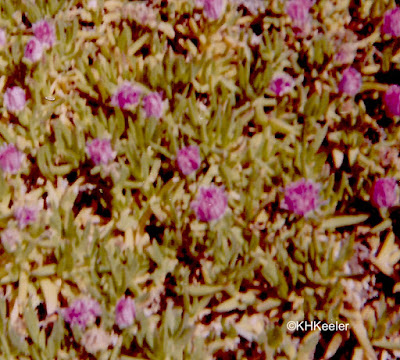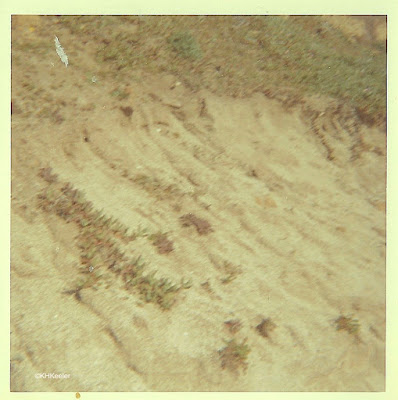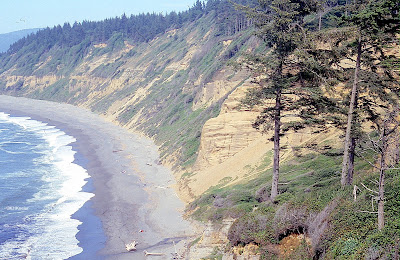I wrote last week about highway iceplant, Carprobrotus edulis (link). In 1970 as a new graduate student at the University of California, Berkeley, I chose to write a paper about it. I had an Anthropology-Zoology major and writing a paper about a plant for Botany Department professor Herbert Baker was well out of my comfort zone. It is true, as I indicated last week, that I seized on iceplant as conspicuous, but there was more to it. During breaks, my roommates and I explored California, especially the coastline. I saw icesplant hanging off the cliffs at the edge of the Pacific and enjoyed incorporating my observatioins and photos into my assignment. Botanists go interesting places, for work.
 |
| Iceplant, Carpobrotus chilensis, California coast 1970 There's a pink flower in the center, 1/5 of the way down |
The plant on the coast, I soon discovered, was a second species, Carpobrotus chilensis. (Carpobrotus means edible fruit in Greek--karpos fruit, brotos edible. while chilensis means "from Chile"). Telling the species apart was not too difficult. Carpobrotus edulis, now called highway iceplant, introduced from South Africa about 1900, has bigger leaves and flowers than C. chilensis, and the triangular succulent leaves are sharply angled, while the leaflets of C. chilensis are rounder. Flowers on C. chilensis were only magenta, flowers on C. edulis could be yellow, though in Berkeley in the 1970 most were magenta.
I don't have a good common name for C. chilensis. The internet says sea-fig. I have always called it iceplant, and distinguished it from the other iceplant by using its scientific name. The sea-fig name is because of the similarity to figs; a round fruit full of tiny seeds in a dark, sweet, thick "jelly." They are edible.
The two differed in habitat, as well. Carpobrotus chilensis clung to the edge of the coast, sometimes hanging from coastal cliffs as in the photo above, while C. edulis grew well inland, sometimes but not all that frequently, to the edge of the beach.
Though there was very little literature on iceplants in 1970, C. chilensis was described as native. It was distributed all along the California coast--a natural-seeming distribution--but nowhere else in North America. It had, they noted, a curious disjunct distribution: the coasts in California and in Chile. Chile has a Mediterranean climate similar to California's and shared a handful other disjunct species with California. That was a neat factoid about C. chilensis.
 |
| Carpobrotus, iceplant This is probably highway iceplant but without scale you can't tell that it is "larger". But this is the look of sea-fig, though it was rarely on flat ground like this. |
I don't have a good photo of sea-fig: here is one at World of Succulents link
1970 was a long time ago. I have been aware for years that Californians decided that highway iceplant, was aggressively invasive, eliminating native plants. For easily 20 years, as opportunity presents itself, they have been removing it. The sea-fig grows right on the coast, is not invasive, and receives very little attention.
I picked up a brochure at the Pacific Grove Museum of Natural History last month that explained the problem with iceplant. I was prepared to defend C. chilensis, but the flier said it was introduced too.
Really?
When I checked, I found that sites like iNaturalist describe both species as introduced, though C. edulis is the problem weed. I dug into the literature and found papers from 1998 and 2005 that called C. chilensis "putative native." But in 2012, Nancy Vivrette summarized C. chilensis for the Jepson Project (Flora of California) and said it was probably introduced from South Africa, like C. edulis. (link)
Sea-fig had always been odd. It is in the plant family Aizoaceae, iceplants, which are primarily South African. Most members of the Aizoaceae outside of South Africa are in temperate Southern Hemisphere sites, like Australia and southern Chile. Getting to Chile's coast from South Africa was possible--but not easy. From Chile to California--? The climate is right but the ocean currents are not favorable. Yet it was widely distributed along the California coast (see map in the Jepson Project link), a distribution that looked natural. Generally, a plant escaping from human introduction would be more common near urban areas or ports and less abundant more distantly. I know I thought "how neat!" about the sea-fig's distribution and didn't question it.
 |
| Carpobrotus chilensis, California coast |
About 1990 American botanists began the Flora of North America project, writing detailed descriptions of every North American plant, where it is found, and how to identify it. It will be 30 volumes, of which 22 have been published. It has caused the scientific names of many North American plants to be changed; looking carefully with modern tools has merged or separated a surprising number of species.
In 2012, Nancy Vivrette, John E. Bleck, and Wayne R. Ferren Jr. wrote about the plant family Aizoaceae for the Flora of North America (link). They looked at old collections of C. chilensis and thought seriously about what they saw. First, there were problems with C. chilensis in Chile. There doesn't seem to be any such plant. Five South African species of Carprobrotus have naturalized in Chile and hybridized with each other, but none matched C. chilensis. There can't be a disjunct distribution if it isn't in Chile. And if the Carpobrotus plants in Chile aren't native to Chile, but introduced from South Africa, what does say for sea-fig? Vivrette et al. concluded that C. chilensis is an old introduction to California from South Africa.
A light went off for me! Oh, of course. Sailing ships visited California from 1542. They came around South America and had plenty of opportunity to land a hardy succulent or two in California. After that, 400 years is plenty of time for a plant to colonize from one end of the California coast to the other, making a seemingly natural distribution. In 1970 we thought large parts of the world were pristine, undisturbed by humans. Today, there's nowhere that we'd say humans haven't walked, and moved things. Odd distributions should be questioned, not accepted.
The origin of C. chilensis remains a puzzle. Vivrette suggested that it was a hybrid Carpobrotus brought from Chile and that since then the Chilean hybrid populations have incorporated other introduced species and evolved, obscuring relations to C. chilensis. Furthermore, in California C. chilensis has hybridized with C. edulis and perhaps others, further reshaping it. There are numerous papers describing the hybridization of C. chilensis and C. edulis across California. So its origin--what plant species hybridized to form it and where?--remains unknown.
(There's a wonderful opportunity here for a DNA study, looking at sea-fig up and down the California coast and comparing the DNA to Carpobrotus species, in California, Chile, and South Africa, to to see what an in-depth look at the DNA says about C. chilensis' relationships. The thing I'd like best about this study is that it requires going up and down the California coast, looking for sea-figs. )
 |
| California coast |
One last comment on Carpobrotus chilensis. Suppose it is a plant of hybrid origin that's been growing on the California coast for 400 years. Suppose it occurs nowhere else in the world. Do we toss it into the "ewww, introduced" bin, or claim it as uniquely Californian? The world is no longer a simple place with "wild" and "human-influenced" clearly delimited. Rather, its a continual process, requiring that we think carefully when defining "native."
Comments and corrections welcome.
Oh, and sorry for no good photos of sea-fig. I need to hit the beach and get some!
References
Klak, C., A. Khunou, G. Reeves and T. Hedderson. 2003. A phylogenetic hypothesis for the Aizoaceae (Caryophyllales) based on four plastid DNA regions. American Journal of Botany 90(10): 1433–1445. 2003.
Roiloa, S. R., P. Alpert, and R. Barreiro. 2019. Differences in physiological integration between invasive and noninvasive introduced clonal species of Carpobrotus. Journal of Plant Ecology 12, (6): 972–981 (available online at https://academic.oup.com/jpe) Accessed 5/2/22
Schierenbeck, K. A., V. V. Symonds, K. G. Gallagher, and J. Bell. 2005. Genetic variation and phylogeographic analyses of two species of Carpobrotus and their hybrids in California. Molecular Ecology. 14 (2): 539-547.
Thorne, R. F. 1972. Major disjunctions in the geographic ranges of seed plants. The Quarterly Review of Biology, Vol. 47, No. 4 (Dec., 1972), pp. 365-411. Iceplant isn't mentioned, but the idea of Mediterranean disjunct distributions is discussed. I don't know what portion of these stories have stood the test of time. There are certainly a number of plants in the same genus in California and Chile. Note: ideas of continental drift became widely accepted in the mid-1970s in the U.S., these distribution arguments were made with continents fixed in place.
Vilá, M. and C. M. D'Antonio. 1998. Fruit choice and seed dispersal of invasive vs. noninvasitve Carpobrotus (Aizoaceae) in coastal California. Ecology 79 (3): 1053-1060 (link)
Vivrette, N..J. 2012b. Carpobrotus chilensis. In Jepson Flora Project (ed). Jepson eFlora. link (14 July 2016, accessed 5/2/22).
Vivrette, N. J. , J.E. Bleck and W. R. Ferren, Jr. 2012. Aizoaceae Martinov. Flora of North America. link (last accessed 5/5/22).
Kathy Keeler, A Wandering Botanist
More at awanderingbotanist.com
Join me on Facebook: https://www.facebook.com/AWanderingBotanist
I vote for "California native" unless more study clearly shows otherwise. There are many plant species of hybrid origin, as well as species that apparently arose after arrival in open habitat (radiation).
ReplyDelete